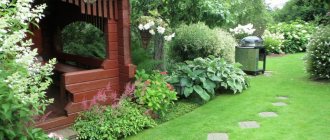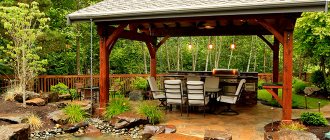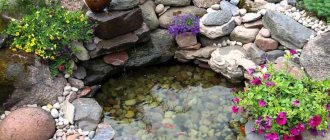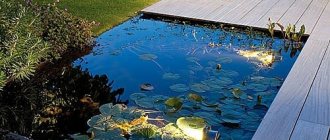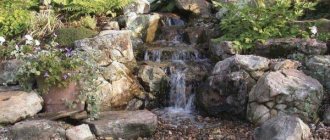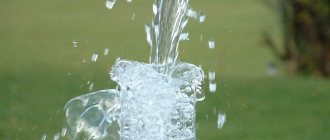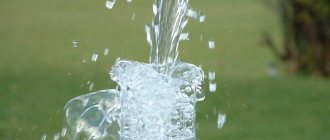A garden pond is a good idea for landscaping. In the modern world, you won’t surprise anyone with flower beds and various garden figurines. I really want the garden to amaze guests with its grace and uniqueness, and therefore the creation of an artificial pond will come in handy, since water itself attracts the eye and can decorate any place.
The pond is considered perhaps the main element of landscape design
A pond as an element of landscape design for a garden
Such elements have long been used by landscape designers and for many have become an everyday thing, so familiar and constantly downloaded from other design projects that they no longer cause such delight as the owners of such decorations expect. This is due to the fault of the designers themselves, who, instead of inventing something new, try to “not strain” and copy old versions of ponds and reservoirs, and simply add a few new decorative elements to differentiate them.
A beautifully designed pond adorns a suburban area
An artificial pond can be used as a large aquarium
But what to do if you want a pond for the garden to be the “face” of the owner and his vision of beauty and unity with nature. To do this, you need to take a closer look at natural reservoirs and find ideas for creating your own small pond in the country or near the house.
A well-designed pond will fit perfectly into the landscape of the site
Decorative lighting plays an important role, allowing you to enjoy a beautiful view at night.
There is no need to make a pile of stone boulders and a small ditch with water near it. First of all, you need to think through its arrangement in your head, and then, in compliance with all technologies and rules, transfer it to the area where it will be located.
Filtration and decoration of the constructed pond
If you decide to build a pond at your dacha, you will definitely have to take care of installing a filter station. It becomes especially relevant if you are breeding fish in a reservoir. Filtration kits can be purchased at specialty stores. Thanks to the available instructions, you can easily cope with their installation and configuration.
Once the filtration equipment is running, you can begin planting. The first deep level can be decorated with a tail or arrowhead. Floating plants, such as lilies, water hyacinths and others, will also look good. You can decorate the space around the pond using ferns, reeds or reeds.
For any summer cottage, an artificial pond will be the main decoration. In addition to plants, you can use stones, figurines, interesting figures, and small trees to decorate a pond. Such elements will help you create a unique composition.
To decorate the bottom of the reservoir, use only round stones that do not have sharp corners. To camouflage the edges, you can plant the shoreline with broadleaf plants. If desired, illumination of the pond can be provided in advance, for which electrical wiring is installed at the stage of forming the pit.
Types of ponds for the garden and their design
A pond in a dacha should stand out and be an integral part of it. To do this, you need to correctly calculate its dimensions, apply modern technologies for its creation, figure out what plants or flowers will surround it and what material will be used to decorate it. The last point is also very important, because the artificial objects surrounding it should look natural and not distract all attention to themselves, but “merge” into one component in the overall solution for decorating the garden.
The first step is to understand the purpose of the reservoir itself.
Water has always attracted attention and beckoned, and in order to create such an island of peace in your garden plot, which in turn will be unique, inimitable, you must first of all be guided by your vision of the world and nature.
A pond with a regular geometric shape looks good in areas decorated in a modern style.
Artificial ponds that imitate natural bodies of water fit well into the landscape of landscape-style areas
When using stones to decorate the border of a pond, you need to distribute them and combine them with small pebbles as nature would do in natural conditions.
Stones of various shapes and sizes are suitable for decorating a pond.
How to draw a sketch of an artificial reservoir
If you do not have experience in designing ponds, then you should turn to specialists so that later you do not have to correct a large number of mistakes made. Any company dealing with artificial reservoirs will provide you with several design options to choose from.
First, a pit is drawn in three projections. The top view has an indication of depths and zones, but the main information it contains is the shape of the reservoir. Two more projections show the width and length of the pond, as well as slopes and depth transitions.
The correct sketch of the pond must contain an indication of all the parameters, as in the figure Source soutsar.ru
When drawing a sketch, to determine the size of the pit, you should use data on the properties of the soil in a certain area. For example, a sand coating does not allow sharp angular transitions, because they crumble very quickly. In this case, the depth changes smoothly, and the water surface has a large area. In general, there are special lists widely available that indicate the optimal bevel angles for different types of soil.
Next, a second sketch is drawn showing the presence and location of all decorative elements, trees and aquatic vegetation. There are no special requirements for accuracy and indication of depths, because the task of such a plan is only to roughly set the appearance of the future reservoir.
The artist’s job is to create a pond design Source liveinternet.ru
Optimal sizes of a pond in a garden plot
In order for the pond not to look ridiculous or awkward on a personal plot, you need to calculate the ratio of the garden itself and the future pond. For example, if the site is large and the pond is small, then this “puddle” will not look attractive. But if the opposite happened, the area is small and most of it is occupied by an artificially constructed pit with water, then this will clutter the entire space and it will be impossible to implement other landscape design ideas.
A pond on your own site can be of almost any size - from a couple of square meters to a pond of significant area
This garden decoration must be made in accordance with the rest of the landscape, so that it does not stand out or get lost against the general background, but is unified with the entire furnishings and decor of this area.
Is it possible to argue with the fact that contemplation of the surface of the water brings a person to tenderness, gives the opportunity to restore strength and mental balance, and allows one to escape from problems for a while. Not everyone has the opportunity to often go out into nature, but it is quite possible to provide yourself and your family with good rest if you build a pond on your summer cottage. The construction of even a small artificial reservoir will make the design of the site much more attractive. You should not be afraid that the construction of a complex hydraulic facility will not be possible - armed with some knowledge in the field of construction, it will not be that difficult to complete all stages of design and construction work with your own hands.
Content
- How to Choose a Pond Style
- Building a reservoir with your own hands - choosing a location, size, video materials
- choosing a place for a pond
- reservoir dimensions
- what materials to use
- artificial pond on the site - construction plan
- Construction of a reservoir, its main stages
- draw up a drawing of the object
- we do local planning
- digging a pit
- how to properly lay film video
- Construction of a stream
- Features of a fish pond
- What water to use to fill the reservoir
- The microclimate in the reservoir must comply with the regulatory video
- What mistakes should you avoid when building a garden pond?
How to Choose a Pond Style
The first issue that will need to be resolved before starting construction is choosing the style of the reservoir. The pond on the site should correspond to the style of the country house and garden and support the landscape concept of the entire site. Depending on your preferences, the pond can be decorated:
- in the Chinese style - with an intricate coastline, with the obligatory bridge and a stone lantern, a “dream” island with a lonely tree or a beautiful stone located on it;
- in Japanese - characterized by minimalism, surrounded by dwarf trees, having an extremely simple rectangular shape, decorated with a composition of stones;
- in a landscape style - naturally blending into the surrounding nature, surrounded by vegetation, possibly a composition of boulders and a path paved with flat stones;
- in the style of a regular garden - with distinct geometric shapes, without being surrounded by lush vegetation;
- in the avant-garde style - with clear straight coastlines, without excessive vegetation, allowing proximity to unusually shaped structures made of glass, plastic or metal;
- in the landscape style, the most picturesque, allowing you to design a free-form reservoir with stones and vegetation growing in the area or exotic, with a bridge and paved paths around it;
- in a formal style with a rectangular outline of the shore or a round one, emphasizing the beauty of the lines of the house located not far from it, with paths made of terrace boards and a bridge made of the same material;
- in the cascade version, the most complex in construction, but very picturesque, creating a special atmosphere of comfort in the garden with the soft murmur of water.
Building a pond with your own hands - how to choose a place to build a pond and determine its optimal size, materials
In order to minimize the problems that arise during operation and ensure its maximum lifespan, you will need to choose a location for the reservoir, taking into account the recommendations of experts.
choosing a place for a pond
It must be taken into account that in a reservoir illuminated throughout the day, green algae develop much more actively, which leads to “water blooming”. Consequently, shadow must fall on the area chosen for placement, at least for several hours a day. It would also be wrong to place a pond in a shaded area of the garden - the ornamental plants planted near it will suffer from the lack of light.
A good option would be to locate the reservoir close to a recreation area with a gazebo, barbecue or barbecue oven - vacationers will always have the opportunity to admire the amazing beauty of the water surface. It is advisable that the southwestern side of the reservoir be open to sunlight for about 5 hours. Large shady trees located near a pond will pollute the water with falling leaves and twigs.
reservoir dimensions
When building a pond with your own hands on a site, you should know that its optimal size can be about 3% of the total area. But if the plot is small, 6 acres, then even 18 square meters. m may turn out to be an unaffordable luxury.
At the same time, creating a small reservoir on your own is much easier; less physical effort will be required, and the cost of materials will be reduced. For this reason, the main criteria for deciding the size of the pond can be considered:
- your financial capabilities,
- the performance of the creators of the future reservoir,
- organic combination of the dimensions of the pond with other structures on the site,
- compliance of the reservoir with the design style of the site.
The depth of the pond is designed depending on the functions that will be assigned to it; the pond should have a depth of three degrees:
- first - for planting coastal plants
- the second - for shallow water plants such as water lilies,
- third - ensuring safe wintering of fish.
You should not achieve a very large depth of the pond - it will be enough to simply equip about a fifth of its area with a depression of about one and a half meters (this is slightly lower than the depth of soil freezing in winter), this is where the fish will spend the winter.
what materials to use
There can be many options for using building materials; their choice mainly depends on the financial capabilities of the site owners. If we talk about a low-budget and pre-fabricated structure, we can mention the option of using a ready-made plastic container, but if a capital structure is planned, then the best option would be to build a pond with a concrete base. It is the most expensive in terms of money and time; in addition to digging a pit, you will need to construct formwork, reinforce it and fill it with concrete.
In practice, polyethylene film is often used to waterproof a reservoir.
artificial pond on the site - construction plan
Installing a pond on the site will require the use of special equipment, first of all, a pump for pumping and filtering water. If you plan to build a budget pond, then a rational option for waterproofing would be to use moisture-resistant film. It is this method of constructing a reservoir that will be considered in this article.
Construction of a reservoir, its main stages
draw up a drawing of the object
First, we draw up a plan diagram, on it we indicate the depth of each of the curtains and their sizes. You will also need to draw up an approximate diagram according to which the decoration of the reservoir will be carried out. The more carefully the design is carried out, the fewer errors and misunderstandings will arise during the work process.
It will also require thinking about how to improve the pond on the site - at this stage we determine which of the components of the water composition can be emphasized - perhaps it will be some unusual plants, stone or sculpture.
we do local planning
When designing, do not forget to provide sufficient space on the ledges for planting plants. You should also provide a place to place each of the functional elements of the reservoir arrangement.
You can mark the outlines of the boundaries of the pond on the ground using ordinary sand, rope or a long watering hose. Next, contours are drawn along them with a solid line. Be sure to make sure that the banks of the reservoir are at the same level. For measurements, you can use either a water level of the required length, or a regular half-meter level, placing it on a long board connecting the opposite banks.
digging a pit
In accordance with the marked lines, a pit is dug. Having dug a hole to the depth of the first tier, mark the boundaries of the curtains and only then continue to dig a hole to the next mark. Having reached the level of the second tier, they mark the area that will be occupied by the deepest part of the reservoir and dig a hole in the pit.
Considering that digging a large pond will require considerable physical effort and time, it may be a rational decision to hire professional diggers or rent a mini-excavator.
If the site is located in a low-lying or swampy area, then you should prepare for a situation when liquid begins to accumulate at the bottom of the hole. In this case, you will need to use a special pump to pump water containing solid and suspended impurities. The pumped out water can be drained into a trench dug nearby.
After completing the digging of the pit, by taking measurements, determine its surface area and find out the dimensions of the waterproofing film. Don’t forget to add about half a meter of material to the edges of the film for allowances.
When digging a pit, a lot of excess soil is formed - you can use it to your advantage. For example, to build the base of an alpine slide or a decorative slide to create a stream flowing into a pond.
When purchasing a film, you should purchase the same amount of geotextile - laying it under the film will prevent possible damage to the polyethylene by plant roots. To save money, you can use used linoleum or roofing felt instead of geotextiles. Sometimes sand is poured into the hole and compacted.
how to lay film correctly
The construction of ponds in the garden always requires waterproofing work, which should be approached with care. After laying a layer of geotextile (linoleum, sand) in the pit, carefully lay the film. A shallow trench is dug along the perimeter of the reservoir and excess film is placed in it so that it holds well, and covered with crushed stone. It will be better to install a heated film, so it is advisable to choose a hot summer day for work. The softened film will smoothly bend around each ledge in the pit.
The edge of the pond can be strengthened with beautifully laid natural stones, decorated with an unusually shaped boulder or a composition of several stone fragments.
Plants prepared in advance are placed in plastic containers and arranged on tiers intended for them. The bottom of the pond is lined with crushed stones or stones.
After completing the preparatory work, you can fill the pond with water.
In this case, it will not be superfluous to take meter readings and remember how much water is required - in the future, this will help you choose the right pumping equipment for pumping water and the volumes of chemical reagents that are used to treat the liquid in the pond during operation.
Construction of a stream
Creating a stream flowing into the pond will help rid the pond of the problem of stagnant water. The source of the stream should be higher than the water level in the reservoir, for example, on a hill built from excess soil. The water supply will be organized using a submersible pump. You should think carefully about masking all components of the water supply system; the mouth of the stream can be decorated with beautiful stones, pebbles, and handmade clay containers. A submersible pump is installed at the bottom of the reservoir, a pipe system is extended from it to the source of the stream, and a pressure cleaning filter must be installed in the system; it works more efficiently than a flow-through one.
The pond is ready for use. Next, it will require periodic maintenance: preventive water treatment, cleaning the water from debris, monitoring the proliferation of algae. For the winter, plants grown in containers are removed from the water and taken to the basement.
Features of a fish pond
To ensure the normal maintenance of fish in the pond and to be able to engage in fishing, it will be necessary to determine the type of fish suitable for breeding in the cramped conditions of a small reservoir. The most unpretentious to the conditions of keeping are crucian carp and carp; in an artificial reservoir, raising two dozen fish will require only 1 cubic meter of water.
The optimal dimensions of a private pond are a depth of about 1.5 m with an area of 25 square meters. The advantage of such a reservoir is the rapid heating of the water to 24-25 degrees - the optimal temperature for the life of fish of the carp family. At a temperature ten degrees lower, the fish's appetite worsens, and there is a decline in their growth activity. It is also dangerous to overheat water to a temperature higher than 30 degrees.
If the owners want to breed crayfish in the pond, then they will need to place old ceramic containers or the remains of pipes on the bottom - the crayfish will need such shelter during the molting period.
What water to use to fill the reservoir
Experts say that any water, including tap water, can be used to fill the pond. But after filling the pond, you should not immediately release fish into it - it is better to wait until the water warms up and microorganisms multiply in it, i.e. she will become “alive”. To speed up the process, you can add at least a few buckets of water from an inhabited reservoir to well or tap water, or simply throw clean mowed grass on the bottom.
To improve the banks of the reservoir in which fish will be bred, reeds and willows are planted.
The microclimate in the reservoir must comply with the standard
Since living creatures will populate the pond, care will need to be taken to create the proper microclimate. The desired environment for breeding fish should have neutral acidity, about 7-8 pH. If the acidity is below normal, add a calculated amount of soda solution or a portion of limestone to the water. Acidity samples should be taken in different parts of the reservoir and at different depths. If the use of additives will only produce temporary changes, then you will have to look for the reason causing the change in acidity.
Before releasing fish into a reservoir, it is necessary to balance the temperature in the tank for transporting fish and in the pond - otherwise the fish may develop temperature shock, in some cases it causes mass death of fish within 24 hours.
What mistakes should you avoid when building a garden pond?
We looked at how to dig a pond on a site; the following recommendations will help you avoid the most common mistakes when performing work:
- You should not use stones of the same shape and size to decorate a pond - such a solution will reduce the decorative effect of the pond and give it a boring look.
- The pond should not be made very deep; a reasonable depth, even in the case of fish farming, is within 2 m.
- You should not be afraid that the soil for growing plants will pollute the water; such soil contains a high percentage of clay, which prevents it from being washed away by water. In addition, actively developing plant roots will help strengthen the soil. However, the container gardening option has its advantages - it makes it possible to quickly regroup the plants and thereby transform the appearance of the reservoir. But the container method of keeping plants has a negative impact on their development and inhibits growth.
Author: Sergey and Svetlana Khudentsov
10
Selecting a location
This point is also important in reproducing a design idea, since it is necessary to provide for its correct location and the proximity of other garden exterior items to this artificial decorative item. If you place it at the end of a plot or somewhere near a fence and clog it with large vegetation, then its very existence may be meaningless and unnecessary.
The location for the pond is chosen from an aesthetic point of view. It will be successful to locate the pond in such a way that you can observe the surface of the water from the windows of the house or while sitting on the recreation area
The optimal place for a pond will be an open space, illuminated for 6-8 hours a day.
Also, a body of water, namely water that shimmers in the light, attracts attention and therefore the proximity of unattractive, old objects or piles of garbage will also attract the attention of visitors to this place. The pond should be placed in the center or slightly to the side, removing unsightly objects away from it.
The pond under the trees will have to be cleared of leaves and twigs more often
Pond with fountain with plastic base
A very interesting landscape idea - a pond with water lilies and lighting, can be implemented at the dacha with your own hands, and exactly how to do this is described step by step with a photo below.
To begin with, it is important to choose a location. You should not place the pond in a lowland, as melt water in the spring will lead to flooding of coastal areas
If there are children in the family, then it is important to place the pond so that it can be seen from the window. After choosing a location, you can begin installation:
When using a pond bath, it is important to mark the outline along the edges of the tank, and when digging a pit, strictly follow it
Dig a pit to the size and depth required. Add a layer of sand and level it with the edge of the bathtub in the pit.
It is important to leave the bathtub in the pit without decoration for a couple of days and water the soil around it with water, as it may sag
Afterwards you can begin to design the coastal zone. Decorate the edges with decorative natural stones, crushed stone and plants.
After the pond is ready, you can design the mouth of the stream and decorate it with stones. If desired, install a fountain or geyser in the center of the pond, connecting all communications. Along the bottom of a pond and stream, you can install special lanterns for ponds. You can add small decorative fish to such a pond and decorate it with lilies.
Selecting size and shape
To create a pond in the garden, there are many plastic forms that can be purchased at garden centers. But if they seem huge there, then when installed their size visually decreases and becomes less voluminous.
The smaller the pond, the more often it has to be cleaned. Lack of space for the inhabitants of the reservoir does not allow the creation of a full-fledged ecosystem
Also, many people want to use old cast-iron bathtubs to create such decor, but this method has long become unprofitable and outdated:
- Firstly, the bathtub is most often white, and the water, in turn, reflects light objects well and therefore dirt, plaque and other debris that accumulates at the bottom become noticeable.
- Also, this form has regular shapes and will not look natural.
Of course, you can repaint the surface of this container in a dark color, but this is expensive and does not justify such costs. So when planning a reservoir, you need to decide what shape it should be, whether there will be a water cycle, fountains, waterfalls.
The easiest way to build an optimal balance between aquatic life and plants is in a large body of water.
Fifth stage. Selecting materials
The next issue that needs to be dealt with is the choice of consumables. There are many options on the modern market that can be used to create an artificial pond. Let's look at them.
concrete pond
The photo shows a concrete pond
The most expensive option, which, nevertheless, allows you to operate the reservoir for quite a long time. Although concrete pouring is more suitable for arranging a swimming pool.
Finished plastic container
Plastic container for pond
This option is more suitable. The mold, made of fiberglass or PVC, allows you to build a pond in record time and use it for up to 30 years (the specific period depends on the quality of the container).
The procedure itself will consist of only four steps:
- digging a pit;
- set the form;
- fill the remaining voids with sand;
- We plant plants and fill the pond with water.
Pond tank installation diagram
The disadvantage of this method is the difficulty of transportation (if the volume is large) and the need for basic installation knowledge (otherwise the bowl may be damaged). Moreover, plastic containers degrade over time when exposed to UV radiation.
Rubber reinforced fiberglass bowl
Polymer film
In terms of pond shape, this option provides simply unlimited possibilities. The most affordable material is polyethylene film, although it will not last long.
Polyethylene film
PVC film has a longer service life; with proper installation, it can last up to ten years.
PVC film
Butyl rubber film
Perhaps the most reliable option. For ponds with a rocky bottom and great depth, it is recommended to use a butyl rubber membrane (EPDM), which has a service life of up to 50 years. In addition, this material can withstand repeated frosts.
Butyl rubber film
There are several folk ways of making a pond, which use available materials. Let's take a look at the most popular of these methods.
Pond from an old bathtub
Diagram of a pond from an old bathtub
An excellent option, because a bathtub is a container that was originally intended to hold liquid. The bathtub can be painted in bright colors and placed in a picturesque corner of the site or, alternatively, buried in the ground.
Tire pond
A simple way to create a mini-reservoir on your site. The manufacturing procedure is shown in the photo below.
Arrangement of a reservoir from a tire
Pond from a basin
An even simpler way. The basin is able to hold water well, so it can be installed in the same way as a bathtub. With proper decoration, such a mini-pond will become an excellent decoration for the yard.
Pond from an old basin
Technology for constructing an artificial pond in the garden
If you plan to create a pond from a finished container, then you need to outline its contours on the ground using sand. Then you need to dig a pit, expanding this mark a little. The base of the pit is well compacted and the container is installed. The distance between the soil and the mold must be filled with sand and watered for several days so that it gives an additive.
Purchased bowls take first place in terms of the speed of creating a reservoir, but you can’t make a large pond out of them - mass-produced containers have a limited square footage
Reservoirs that are created at random are equipped with a special film or fiber. They cover the bottom of a dug pit, letting about 50 cm rise to the top and pressing down the edges with stones. Between the film and the ground you can put a layer of non-woven fabric, which will protect the material used from damage.
A pond of large size and a “free” configuration is made using film - PVC or butyl rubber
The construction of such a pond will take much longer
If you need the most durable and reliable reservoir, the bowl is cast from reinforced concrete
Pond waterproofing
When creating ponds, it is best to use butyl rubber waterproofing (EPDM membrane). At the moment, this is the most reliable waterproofing for creating reservoirs of any complexity and purpose. We use the EPDM membrane Polygomma Pond Liner to build our ponds. This is a high-quality two-layer waterproofing made from synthetic rubber. It is stronger, more elastic and more durable than PVC films. In addition, this material is environmentally friendly and can be used to create swimming pools and multifunctional ponds.
To prevent damage to the membrane by stones or tree roots, a layer of dense geotextile should first be placed on the bottom and walls of the pit and secured to the soil on the shoreline with metal staples.
On the website waterlilia.ru you can find comprehensive information about growing nymphs and choose a plant that is suitable specifically for your pond. And on the nursery’s YouTube channel you will find reviews of various varieties of nymphs, as well as many useful videos that will help make caring for your pond easier.
Choosing plants for a garden pond
A dacha pond is not only water and stones, but also the vegetation that grows in it and along its banks. Plants used for planting directly in water not only saturate it with oxygen, but also protect it from direct sunlight, preventing it from blooming.
Aquatic plants perform an important task - they are natural filters for water.
The most popular plants for these purposes are underwater buttercups, marsh marigold, and pontederia. It is best to choose unpretentious perennials.
Water lilies are one of the most beautiful aquatic plants. Planted at a depth of 20 to 50 cm depending on the variety
In the coastal zone, marsh calamus is planted, which forms spectacular groups of stems and leaves rising above the water
Construction of a reservoir. Stage 3.
3. A 10-15 cm layer of sand is poured onto the bottom, then the pit is covered with synthetic protective material (geotextile). Geotextiles are used to protect waterproofing from mechanical damage. This is especially necessary for deep reservoirs, in cases where the reservoir is located on rocky soils and if trees grow near it. The protective material has a small width and is laid overlapping at the joints (5-10 cm).
The waterproofing is laid on the prepared bed. Wrinkles at corners and along curved banks of a pond are inevitable, but they will be less noticeable if the insulating material is carefully straightened before filling the reservoir. The protruding edge of the insulating coating is pressed against the stones. Avoid tension on the waterproofing.
To avoid the film from floating up (due to flooding of the reservoir by groundwater and melt water), large stones are laid at the bottom of the reservoir, and geotextiles must also be placed under them. At this stage, hoses for pumps and filters are laid, as well as a network cable. You can place aquatic plants in containers on the terraces if this will be difficult after filling the reservoir.
Planting aquatic plants
If the pond is small, then you should not plant more than two or three types of plants in it, and no more than 6-7 in a large one. To form a small garden, you need to use different plants, but you need to know which ones are suitable for deep water areas and which ones are planted in shallow waters.
Each type of aquatic plant requires planting at a certain depth.
The marsh iris thrives in shallow waters and is especially attractive during the flowering period.
Calla lily or marsh calla are used to decorate the coastal zone.
Examples of ponds of different sizes in garden landscape design
By using modern technologies, various decorative elements and your imagination, then you can turn your ordinary area into an original and fashionable place that will delight guests and give peace and tranquility to family members.

